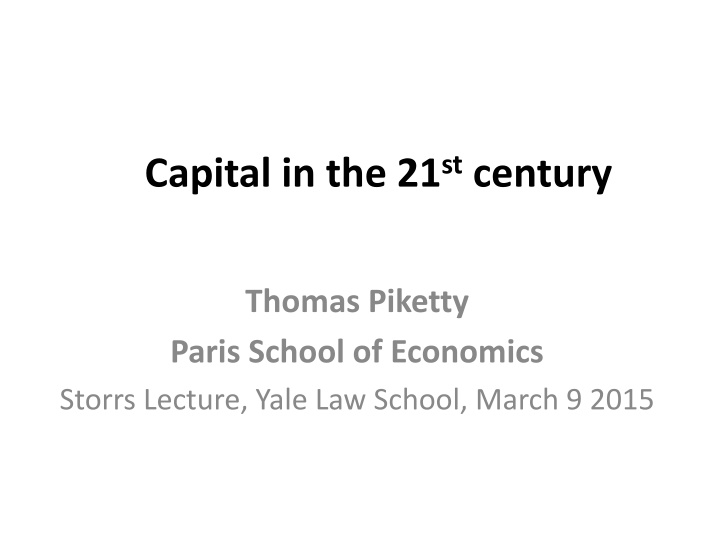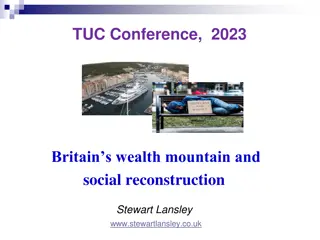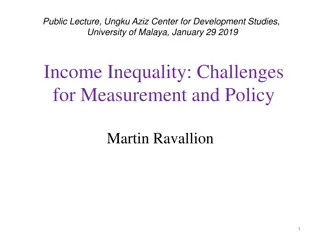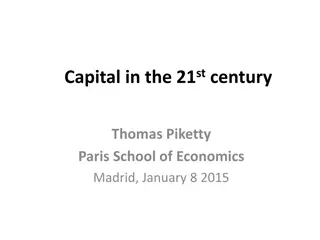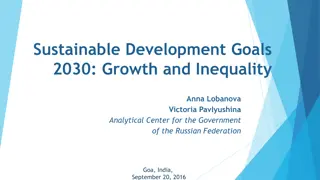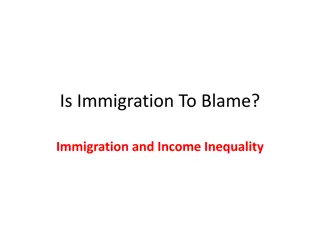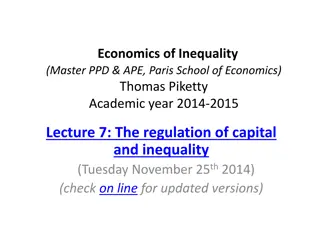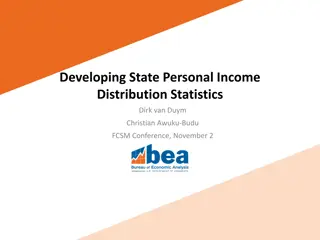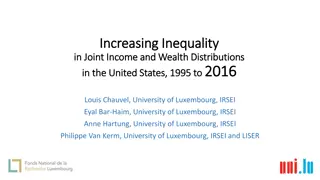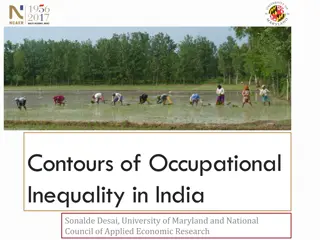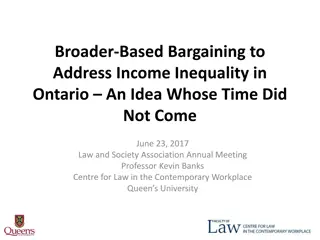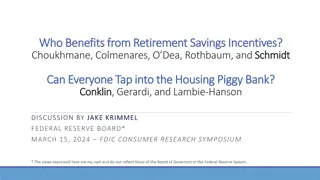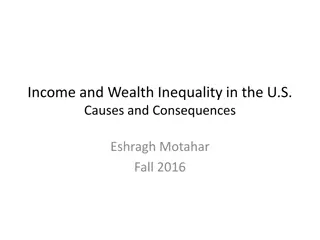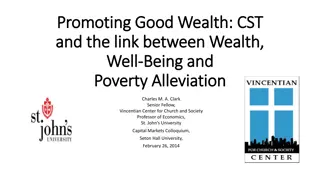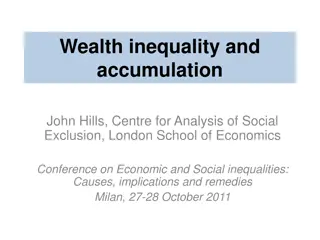Dynamics of Income and Wealth Inequality in the 21st Century
French economist Thomas Piketty discusses the global dynamics of income and wealth distribution since the 18th century in his presentation, highlighting the shift from rising income inequality to rising wealth inequality. He delves into the long-term evolution of capital/income ratios, wealth concentration, and the future implications of wealth inequality in the 21st century.
Download Presentation

Please find below an Image/Link to download the presentation.
The content on the website is provided AS IS for your information and personal use only. It may not be sold, licensed, or shared on other websites without obtaining consent from the author.If you encounter any issues during the download, it is possible that the publisher has removed the file from their server.
You are allowed to download the files provided on this website for personal or commercial use, subject to the condition that they are used lawfully. All files are the property of their respective owners.
The content on the website is provided AS IS for your information and personal use only. It may not be sold, licensed, or shared on other websites without obtaining consent from the author.
E N D
Presentation Transcript
Capital in the 21stcentury Thomas Piketty Paris School of Economics Storrs Lecture, Yale Law School, March 9 2015
This presentation is based upon Capital in the 21stcentury (Harvard University Press, March 2014) This book studies the global dynamics of income and wealth distribution since 18c in 20+ countries; I use historical data collected over the past 15 years with Atkinson, Saez, Postel-Vinay, Rosenthal, Alvaredo, Zucman, and 30+ others; I try to shift attention from rising income inequality to rising wealth inequality The book includes four parts: Part 1. Income and capital Part 2. The dynamics of the capital/income ratio Part 3. The structure of inequalities Part 4. Regulating capital in the 21stcentury In this presentation I will present some results from Parts 2 & 3, focusing upon the long-run evolution of capital/income ratios and wealth concentration (all graphs and series are available on line: see http://piketty.pse.ens.fr/capital21c )
This presentation: three points 1. The long-run dynamics of income inequality. The end of the Kuznets curve, the end of universal laws. Country-specific institutions and policies matter. 2. The return of a patrimonial (or wealth-based) society in the Old World (Europe, Japan). Wealth-income ratios seem to be returning to very high levels in low growth countries. The metamorphosis of capital. 3. The future of wealth concentration: with high r - g during 21c(r = net-of-tax rate of return, g = growth rate), then wealth inequality might reach or surpass 19c oligarchic levels. Need for for more transparency.
Three facts about inequality in the long-run: income inequality, wealth-inequality, wealth-income ratios (Piketty-Saez, Inequality in the long run , Science 2014) Fact n 1: in 1900-1910, income inequality was higher in Europe than in the United States; in 2000-2010, it is a lot higher in the United States
Figure 1. Income inequality: Europe and the U.S., 1900-2010 50% Share of top income decile in total pretax income (decennial averages) Top 10% income share: Europe 45% Top 10% income share: U.S. 40% 35% 30% 25% 1900 1910 The share of total income accruing to top decile income holders was higher in Europe than in the U.S. around 1900- 1910; it is a lot higher in the U.S. than in Europe around 2000-2010. Sources and series: see piketty.pse.ens.fr/capital21c (fig.9,8) 1920 1930 1940 1950 1960 1970 1980 1990 2000 2010
Figure I.1. Income inequality in the United States, 1910-2012 50% Share of top decile in total income (including capital gains) Share of top decile in national income Excluding capital gains 45% 40% 35% 30% 25% 1910 1920 The top decile share in U.S. national income dropped from 45-50% in the 1910s-1920s to less than 35% in the 1950s (this is the fall documented by Kuznets); it then rose from less than 35% in the 1970s to 45-50% in the 2000s-2010s. Sources and series: see 1930 1940 1950 1960 1970 1980 1990 2000 2010
Figure 1. Income inequality: Europe and the U.S., 1900-2010 50% Share of top income decile in total pretax income (decennial averages) Top 10% income share: Europe 45% Top 10% income share: U.S. 40% 35% 30% 25% 1900 1910 The share of total income accruing to top decile income holders was higher in Europe than in the U.S. around 1900- 1910; it is a lot higher in the U.S. than in Europe around 2000-2010. Sources and series: see piketty.pse.ens.fr/capital21c (fig.9,8) 1920 1930 1940 1950 1960 1970 1980 1990 2000 2010
Top 10% Income Share: Europe, U.S. and Japan, 1900-2010 50% U.S. 45% Europe Share of top decile in total income Japan 40% 35% 30% 25% 1900 1910 The top decile income share was higher in Europe than in the U.S. in 1900-1910; it is a lot higher in the U.S. in 2000-2010. Sources and series: see piketty.pse.ens.fr/capital21c. 1920 1930 1940 1950 1960 1970 1980 1990 2000 2010
The rise in US inequality in recent decades is mostly due to rising inequality of labor income It is due to a mixture of reasons: changing supply and demand for skills; race between education and technology; globalization; more unequal to access to skills in the US (rising tuitions, insufficient public investment); unprecedented rise of top managerial compensation in the US (changing incentives, cuts in top income tax rates); falling minimum wage in the US institutions and policies matter
This presentation: three points 1. The long-run dynamics of income inequality. The end of the Kuznets curve, the end of universal laws. 2. The return of a patrimonial (or wealth-based) society in the Old World (Europe, Japan). Wealth-income ratios seem to be returning to very high levels in low growth countries. Intuition: in a slow-growth society, wealth accumulated in the past can naturally become very important. In the very long run, this can be relevant for the entire world. Not bad in itself, but new challenges. The metamorphosis of capital call for new regulations of property relations. 3. The future of wealth concentration: with high r - g during 21c, then wealth inequality might reach or surpass 19c oligarchic levels.
Fact n2: wealth inequality is always a lot higher than income inequality; it is now higher in the US than in Europe Fact n 3: wealth inequality is less extreme today than a century ago in Europe, although the total capitalization of private wealth relative to national income has now recovered from the 1914-1945 shocks
Figure 2. Wealth inequality: Europe and the U.S., 1870-2010 100% Share of top wealth decile in total net wealth (decennial averages) Top 10% wealth share: Europe 90% Top 10% wealth share: U.S. 80% 70% 60% 50% 1870 1890 1910 1930 1950 1970 1990 2010 The share of total net wealth belonging to top decile wealth holders has become higher in the US than in Europe over the course of the 20thcentury. But it is still smaller than what it was in Europe before World War 1. Sources and series: see piketty.pse.ens.fr/capital21c (fig.10,6)
Figure 3. Wealth-income ratios: Europe and the U.S., 1900-2010 700% Total market value of net private wealth (% national income) 600% Europe U.S. 500% (decennial averages) 400% 300% 200% 1900 1910 1920 1930 1940 1950 1960 1970 1980 1990 2000 2010 Total net private wealth was worth about 6-7 years of national income in Europe prior to World War 1, down to 2-3 years in 1950-1960, back up to 5-6 years in 2000-2010. In the US, the U-shapped pattern was much less marked. Sources and series: see piketty.pse.ens.fr/capital21c (fig.5,1)
The metamorphosis of capital There s nothing bad with high wealth-income ratios (postwar reconstruction, growth slowdown), but this creates new policy challenges: financial regulation, real estate bubbles, return of inheritance A multidimensional approach to the history of capital and property relations: from land to business assets, foreign assets, real estate, public debt, immaterial capital, etc.
Figure S5.2. Private capital in rich countries: from the Japanese to the Spanish bubble 800% U.S.A Japan Germany France 700% Value of private capital (% of national income) U.K. Italy Canada Australia 600% Spain 500% 400% 300% 200% 100% 1970 1975 1980 1985 1990 1995 2000 2005 2010 Private capital almost reached 8 years of national income in Spain at the end of the 2000s (ie. one more year than Japan in 1990). Sources and series: see piketty.pse.ens.fr/capital21c.
Capital & inequality in America Inequality in America = a different structure as in Europe: more egalitarian in some ways, more inegalitarian in others The New World in the 19thcentury: the land of opportunity (capital accumulated in the past matters less than in Europe; perpetual pop. growth as a way to reduce the level of inherited wealth and wealth concentration) and also the land of slavery: extreme form of property relation Northern US were in many ways more egalitarian than Old Europe; but Southern US were more inegalitarian We still have the same ambiguous relationship of America with inequality today: in some ways more merit-based; in other ways more violent ( meritocratic extremism )
Capital & inequality in Germany Lower market values of capital assets in Germany: lower real estate prices, and lower stock market capitalization of corporations Stakeholder capitalism: shareholders have to share power with worker representatives, regional govt, etc., so that the market value is much less than book value of corporation Apparently this does not prevent German companies from producing good cars This clearly illustrates that market and social values of capital can differ; property relations are socially, legally and historically determined
This presentation: three points 1. The long-run dynamics of income inequality. The end of the Kuznets curve, the end of universal laws. Country- specific institutions and policies matter. 2. The return of a patrimonial (or wealth-based) society in the Old World (Europe, Japan). Wealth-income ratios seem to be returning to very high levels in low growth countries. 3. The future of wealth concentration: with high r - g during 21c(r = net-of-tax rate of return, g = growth rate), then wealth inequality might reach or surpass 19coligarchic levels. Conversely, suitable institutions can allow to democratize wealth. Strong need for more transparency about global wealth dynamics and cross-border financial assets, in rich countries as well as in emerging countries (China, Latin America, Africa).
Figure 2. Wealth inequality: Europe and the U.S., 1870-2010 100% Share of top wealth decile in total net wealth (decennial averages) Top 10% wealth share: Europe 90% Top 10% wealth share: U.S. 80% 70% 60% 50% 1870 1890 1910 1930 1950 1970 1990 2010 The share of total net wealth belonging to top decile wealth holders has become higher in the US than in Europe over the course of the 20thcentury. But it is still smaller than what it was in Europe before World War 1. Sources and series: see piketty.pse.ens.fr/capital21c (fig.10,6)
Conclusions The history of income and wealth inequality is deeply political, social and cultural; it involves beliefs systems, national identities and sharp reversals In a way, both Marx and Kuznets were wrong: there are powerful forces pushing in the direction of rising or reducing inequality; which one dominates depends on the institutions and policies that different societies choose to adopt High r-g can push toward high wealth concentration, but many other forces are also important The ideal solution: progressive taxation, social state, financial transparency, economic democracy Other solutions involve authoritarian political & capital controls (China, Russia), or perpetual population growth (US) US high-inequality trap: oligarchic capture, or lack of historical experience with oligarchy ?
Supplementary slides (long lecture version)
The return of a wealth-based society Wealth = capital K = everything we own and that can be sold on a market (net of all debts) (excludes human K, except in slave societies) In textbooks, wealth-income & capital-ouput ratios are supposed to be constant. But the so-called Kaldor facts actually rely on little historical evidence. In fact, we observe in Europe & Japan a large recovery of =K/Y in recent decades: =200-300% in 1950-60s =500-600% in 2000-10s (i.e. average wealth K was about 2-3 years of average income Y around 1950-1960; it is about 5-6 years in 2000-2010) (with 600%, if Y 30 000 per capita, then K 180 000 per capita) (currently, K half real estate, half financial assets) Are we heading back to the =600-700% observed in the wealth-based societies of 18c-19c ? Or even more?
The simplest way to think about this is the following: in the long-run, =s/g with s = (net-of-depreciation) saving rate and g = economy s growth rate (population + productivity) With s=10%, g=3%, 300%; but if s=10%, g=1,5%, 600% = in slow-growth societies, the total stock of wealth accumulated in the past can naturally be very important capital is back because low growth is back (in particular because population growth 0) in the long run, this can be relevant for the entire planet Note: =s/g = pure stock-flow accounting identity; it is true whatever the combination of saving motives
Will the rise of capital income-ratio also lead to a rise of the capital share in national income? If the capital stock equals =6 years of income and the average return to capital is equal r=5% per year, then the share of capital income (rent, dividends, interest, profits, etc.) in national income equals = r x = 30% Technically, whether a rise in also leads to a rise in capital share = r depends on the elasticity of substitution between capital K and labor L in the production function Y=F(K,L) Intuition: measures the extent to which workers can be replaced by machines (e.g. Amazon s drones) Standard assumption: Cobb-Douglas production function ( =1) = as the stock , the return r exactly in the same proportions, so that = r x remains unchanged, like by magic = a stable world where the capital-labor split is entirely set by technology But if >1, then the return to capital r falls less than the volume of capital , so that the product = r x Exactly what happened since the 1970s-80s: both the ratio and the capital share have increased
With a large rise in , one can get large rise in with a production function F(K,L) that is just a little bit more substituable than in the standard Cobb-Douglas model (say if =1,5 instead of 1) Maybe it is natural to expect over the course of history: more and more diversified uses for capital; extreme case: pure robot-economy ( =infinity) Less extreme case: there are many possible uses for capital (machines can replace cashiers, drones can replace Amazon s delivery workers, etc.), so that the capital share continuously; there s no natural corrective mechanism for this The rise of and can be a good thing (we could all devote more time to culture, education, health , rather than to our own subsistance), assuming one can answer the following question: who owns the robots?
The future of wealth concentration In all European countries (UK, France, Sweden ), wealth concentration was extremely high in 18c-19c& until WW1: about 90% of aggregate wealth for top 10% wealth holders about 60% of aggregate wealth for top 1% wealth-holders = the classic patrimonial (wealth-based) society: a minority lives off its wealth, while the rest of the populaton works (Austen, Balzac) Today wealth concentration is still very high, but less extreme: about 60-70% for top 10%; about 20-30% for top 1% the bottom 50% still owns almost nothing (<5%) but the middle 40% now owns 20-30% of aggregate wealth = the rise of a patrimonial middle class How did it happen, and will it last? Will the patrimonial middle class expend, or will it shrink?
